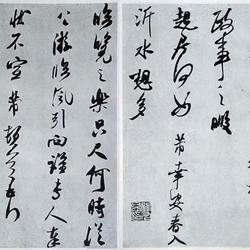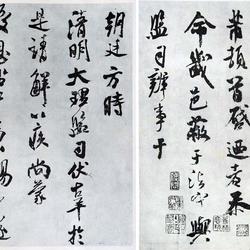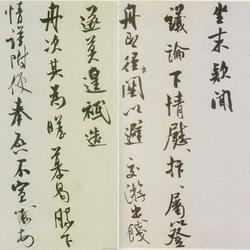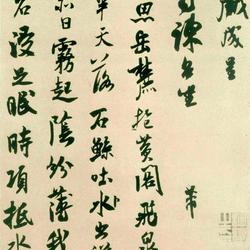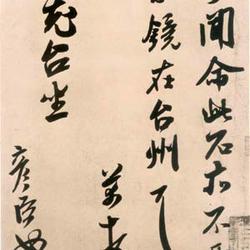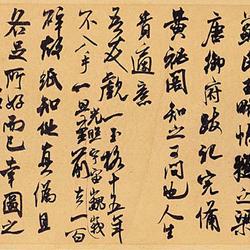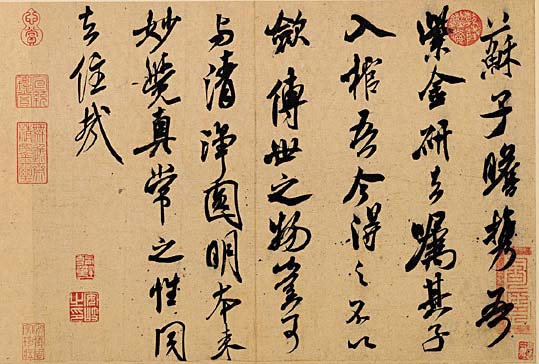
Mi Fu's "Purple Gold Research Paper", paper, running script, 28.2 cm long and 39.7 cm wide, collected by the National Palace Museum in Taipei.
Explanation:
Su Zizhan takes me with him
Zijin went to study and asked his son to
Into the coffin. I have obtained it now, but I will not
Convergence. How can something handed down from generation to generation be
With the original purity and enlightenment
The true and constant nature of wonderful enlightenment is the same
Go and live
Appendix; Strange and graceful, full of vitality
——Appreciation of "Zijin Yantie" in running script by Mi Fu (Author: Donghua)
Mi Fu's "Zijin Yantie", on pale tooth-colored paper, in running script. 29 cm long and 40 cm wide. There are "Inspection Division Seal" (half seal), "Anqi Seal", "Qianlong Appreciation", "Xuantong Appreciation" and other appreciation seals. It is recorded in the collection of "Four Masters of Calligraphy of the Song Dynasty" collected by the Palace Museum. There is a copy of "Sanxitang Dharma Calligraphy". It is also recorded in "Shigutang Calligraphy and Painting Collection" and "Moyuan Huiguan". It is the most famous masterpiece of Mi Fu's calligraphy handed down from generation to generation. one.
From this post, we can see that Mi Fu's so-called "brush" word actually means that he spread the brush hair flat on the paper so that the brush strokes can produce the effect of "thousands of brush strokes". Therefore, it can be said that Mi Fu's "brushing" method is adapted to the new changes in techniques since the development of running script into the Song Dynasty and the road to "shangyi".
Calligraphy before the Qin and Han Dynasties naturally also emphasized the beauty of smoothness. It is said that during the Qin Dynasty, Meng Tian once said on the use of pens: "If you can use a pen, you should be able to flow beautifully." However, this kind of "flowing beauty" means that "all books are not only wrapped and flowing quickly, but also light and strong thanks to the power of the pen" (Qin· Li Si Lun Shu Yu). Therefore, the term "flowing beauty" in early Chinese calligraphy was set up to use the center of the brush to make the stipple lines look like "jade chopsticks". Afterwards, although the calligraphy style began to move towards the state of "the calligraphy technique is as disturbing as climbing into the battle array, flexible and in front of the wrist, civil and military forces are used in the pen, there must be leaning when coming and going, opening and closing books are based on yin and yang" (Han Xiao He Lun Shu Yu), However, the emphasis on calligraphy in this period is still the external visual beauty of calligraphy, which has not yet reached the aesthetic level of making calligraphy's stipple lines have the beauty of "bones", "muscles strong", "flesh" and "bloody" .
Of course, in the calligraphy of the Tang Dynasty, the conscious pursuit of sinews, bones, flesh, and blood in calligraphy had begun. However, this period was still in the exploratory stage, and there was no particularly successful theoretical summary. However, by the Song Dynasty, the "bones" The pursuit of "strong", "strong muscles", "flesh" and "blood vitality" not only has a clear theoretical description, but also has the emergence of calligraphy masterpieces such as Mi Fu's "Zijin Yantie".
Mi Fu's "Zi Jin Yan Tie" is indeed made of fine hair being laid flat on the paper, producing the effect of "ten thousand millimeters of force", and making the calligraphy have "bones", "muscles strong", "flesh" and "blood". A masterpiece of calligraphy with a sense of "living" beauty. This writing technique of "laying the paper flat and applying all the force" is like the way Chinese people use "chopsticks" when eating - just two thin sticks that can be "clamped" or "pecked" under the action of fingers. ", can be "talked about", can be "picked", and can also be "crossed". In short, it is flexible and practical and serves people's convenience. According to calligraphy, the brushwork of "thousands of millimeters of force spread out on the paper" can also be "pecked" under the influence of the calligrapher's luck, such as the two dots of the word "Su" in "Zijin Yantie". The writing method of dot on the word "Zhi" can be "dao", such as the beginning of many horizontal strokes in the post; it can even be "clip", which is a "衄" method, such as the lower two characters of the character "qi" in the post. Dot; can be "crossed", such as the two strokes of the pen closing the word "wu" in the post. In short, Mi Fu's "Zijinyan Tie" is a product to make calligraphy thick and strong, full of muscle and flesh, and to be able to use the pen flexibly and gracefully. Masters of calligraphy after the Song Dynasty, such as Xian Yushu in the Yuan Dynasty, Wu Kuan, Xu Wei, Huang Daozhou, and Ni Yuanlu in the Ming Dynasty, and Wang Duo and Fu Shan in the Qing Dynasty, all became outstanding masters after deeply studying Mi Fu's calligraphy.

